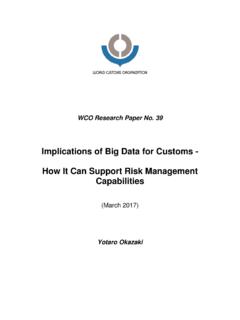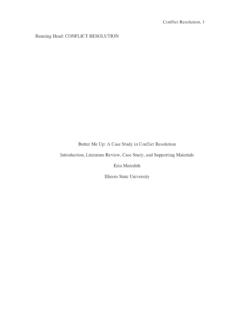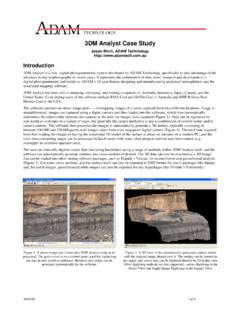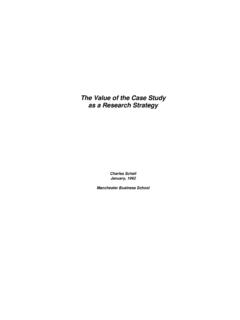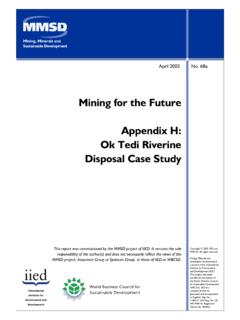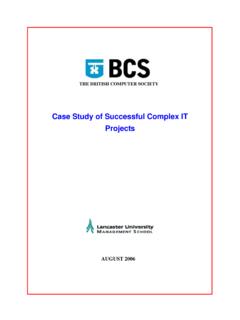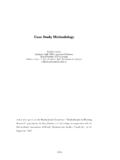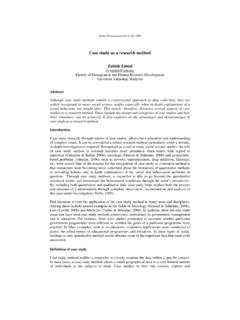Transcription of CASE STUDY 14.2 USE OF TRANSFER PRICING …
1 DISCLAIMER: THIS TEXT HAS BEEN ADOPTED BY THE TECHNICAL COMMITTEE ON CUSTOMS VALUATION AND IS SUBJECT TO APPROVAL BY WCO COUNCIL CS case STUDY USE OF TRANSFER PRICING DOCUMENTATION WHEN EXAMINING RELATED PARTY TRANSACTIONS UNDER ARTICLE (a) OF THE AGREEMENT Introduction 1. This document describes a case where Customs took into account information provided in a company s TRANSFER PRICING report, as well as additional information, when determining whether or not the price actually paid or payable for imported goods had been influenced by the relationship between buyer and seller under Article (a) of the Agreement.
2 This case STUDY does not indicate, imply, or establish any obligation on Customs authorities to utilize the OECD Guidelines and the documentation resulting from the application of the OECD Guidelines in interpreting and applying the WTO Valuation Agreement. Facts of Transaction 2. XCO of country X sells luxury bags to ICO, a distributor of country I. Both XCO and ICO are wholly-owned subsidiaries of ACO, the headquarters of a multinational enterprise and the brand-owner of the luxury bags. Neither XCO nor other companies related to ACO sell the identical or similar luxury bags to unrelated buyers in country I.
3 ICO is the only importer of the luxury bags sold by XCO to country I. Thus, all luxury bags imported into country I by ICO are purchased from XCO. 3. In 2012, ICO declared the price of imported luxury bags based on the value on the invoice issued by XCO. The commercial documents submitted to Customs of country I indicated that there was no special circumstances or additional payments which would prevent the use of the transaction value as set out in subparagraphs (a) to (c) of Article 1 of the Agreement or require an additional adjustment prescribed by Article 8 to the import price.
4 4. In 2013, Customs in country I conducted a Post-Clearance Audit to verify ICO s declared import price, because it had doubts about the acceptability of the price. ICO s TRANSFER PRICING policy showed that the import price of all luxury bags was determined using the Resale Price Method (in accordance with the TRANSFER PRICING Guidelines for Multinational Enterprises and Tax Administrations of the Organisation for Economic Co-operation and Development). At the end of each year, ICO calculated the import price of luxury bags based on the resale price and the targeted gross margin for the next year as recommended by XCO.
5 After the targeted gross margin for 2012 was determined at 40%, ICO then calculated the import price of luxury bags to be imported in 2012 by using the Resale Price Method according to the formula: Import Price = recommended Resale Price x (1 Targeted Gross Margin) / (1 + Duty Rate). 5. ICO is a simple or routine distributor. The marketing strategy for the sales of bags in country I is in fact established by XCO. XCO also advises on the levels of inventory to be maintained, and establishes the recommended sales price of the bags sold by ICO, including the discounting policy to be used by ICO.
6 XCO has also invested heavily in developing valuable intangible assets associated with the bags. As a result, XCO assumes the market risk and price risk in relation to the sales of the bags in country I. CS 6. The luxury bag market of country I where the imported goods were resold has been very competitive. However, in 2012, the actual sales income of ICO far exceeded the estimated income since more bags were sold at full price, and fewer at a discounted price, than anticipated. Consequently, ICO s gross margin in 2012 was 64 % which was higher than the targeted gross margin stated in ICO s TRANSFER PRICING policy.
7 During the audit, Customs asked ICO to provide further information in order to review the acceptability of its declared import price. 7. ICO did not provide test values required for the application of Article (b) and (c), as a means of demonstrating that the relationship did not influence the price. However, ICO submitted a TRANSFER PRICING report, which used the Resale Price Method that compared ICO s gross margin with the gross margins earned by comparable companies in their transactions with unrelated parties ( comparable uncontrolled transactions).
8 The TRANSFER PRICING report was prepared by an independent firm following the process set out in accordance with the OECD TRANSFER PRICING Guidelines. 8. According to the TRANSFER PRICING report, ICO does not employ any valuable, unique intangible assets or assumed any significant risk. The TRANSFER PRICING report submitted by ICO selected eight comparable companies located in country I. The functional analysis indicated that the eight selected comparable companies imported comparable products from country X, performed similar functions, assumed similar risks and did not employ any valuable intangible assets, just as ICO.
9 9. The TRANSFER PRICING report indicated that the arm s length (inter-quartile) range of gross margins earned by the selected comparable companies in 2012 was between 35 %-46 %, with a median of 43 %. Therefore, the 64 % gross margin earned by ICO did not fall within the arm s length inter-quartile range. At the time Customs conducted its valuation audit, it was established that, in this particular case , ICO had not made any TRANSFER PRICING adjustments in this regard. Issue for Determination 10. Does the TRANSFER PRICING report, supplied in this case , provide information which enables Customs to conclude whether or not the price actually paid or payable for the imported goods is influenced by the relationship of the parties under Article 1 of the Agreement?
10 Analysis 11. Under Article 1 of the Agreement, a transaction value is acceptable as the Customs value when the buyer and the seller are not related, or if related, the relationship does not influence the price. Where the buyer and seller are related, Article of the Agreement provides two ways of establishing the acceptability of the transaction value when Customs have doubts concerning the price: (1) the circumstances surrounding the sale shall be examined to determine whether the relationship influenced the price (Article (a)); or (2) the importer demonstrates that the value closely approximates one of three test values (Article (b)).


